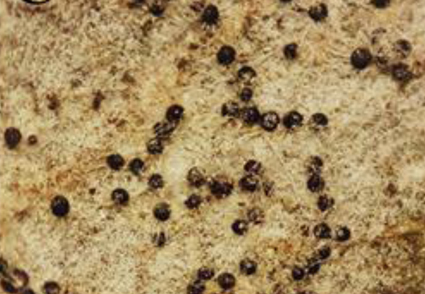Abstract
A new powdery mildew fungus, Erysiphe pakistanica (Erysiphaceae) infecting Indian willows is described from north-western areas of Pakistan. Identification is based upon morpho-anatomical features and molecular analysis. This species is characterized by having nipple-shaped appressoria, small chasmothecia and ascospores. Phylogenetic analysis of nrDNA of ITS and LSU regions of E. pakistanica supports its novel identity within the genus Erysiphe (Sect. Uncinula). A comprehensive description along with photographs and phylograms to show its exact position and a comparison with closely related taxa is provided.
References
Ali, S.I. (2001) Salicaceae. In: Ali, S.I. & Qaiser, M. (Eds.) Flora of Pakistan No. 203. Department of Botany, University of Karachi and Missouri Botanical Press, Missouri Botanical Garden, St, Louis, Missouri, U.S.A., pp. 1–60.
Awan, A.A., Akhtar, T. & Dar, M.E.U.I. (2007) Fodder plants of some selected areas of Jhelum Valley. Pakistan Journal of Biological Sciences 10 (9): 1547–1549. https://doi.org/10.3923/pjbs.2007.1547.1549
Braun, U. & Cook, R.T.A. (2012) Taxonomic manual of Erysiphales (powdery mildews). CBS Biodiversity Series 11: 1?707.
Braun, U., Takamatsu, S., Heluta, V., Limkaisang, S., Divarangkoon, R., Cook, R. & Boyle, H. (2006) Phylogeny and taxonomy of powdery mildew fungi of Erysiphe sect. Uncinula on Carpinus species. Mycological Progress 5 (3): 139–153. https://doi.org/10.1007/s11557-006-0509-6
Cunnington, J.H., Takamatsu, S., Lawrie, A.C. & Pascoe, I.G. (2003) Molecular identification of anamorphic powdery mildews (Erysiphales). Australasian Plant Pathology 32 (3): 421?428. https://doi.org/10.1071/AP03045
Darsaraei, H., Khodaparast, S.A., Takamatsu, S., Abbasi, M., Asgari, B., Sajedi, S., Götz, M., Liu, S.Y., Feng, J., Bradshaw, M., Bulgakov, T. & Braun, U. (2021) Phylogeny and taxonomy of the Erysiphe adunca complex (Erysiphaceae, Helotiales) on poplars and willows. Mycological Progress 20 (4): 517–537. https://doi.org/10.1007/s11557-021-01688-7
Divarangkoon, R., Meeboon, J., Monkhung, S., To-anun, C. & Takamatsu, S. (2011) Two new species of Erysiphe (Erysiphales, Ascomycota) from Thailand. Mycosphere 2 (3): 231–238.
Gligori?, E., Igi?, R., Suvajdži?, L. & Gruji?-Leti?, N. (2019) Species of the genus Salix L.: biochemical screening and molecular docking approach to potential acetylcholinesterase inhibitors. Applied Sciences 9 (9): 1842. https://doi.org/10.3390/app9091842
Khan, A.G. (2004) Technical report on the characterization of the agroecological context in which FAnGR (farm animal genetic resource) are found development and application of decision support tools to conserve and sustainably use genetic diversity in indigenous livestock and wild relatives. Islamabad, Pakistan.
Khan, W., Khan, S.M. & Ahmad, H. (2015) Altitudinal variation in plant species richness and diversity at Thandiani sub forests division, Abbottabad, Pakistan. Journal of Biodiversity and Environmental Sciences 7 (1): 46–53.
Khan, W., Khan, S.M., Ahmad, H., Alqarawi, A.A., Shah, G.M., Hussain, M. & Abd_Allah, E.F. (2018) Life forms, leaf size spectra, regeneration capacity and diversity of plant species grown in the Thandiani forests, district Abbottabad, Khyber Pakhtunkhwa, Pakistan. Saudi Journal of Biological Sciences 25 (1): 94–100. https://doi.org/10.1016/j.sjbs.2016.11.009
Malik, S.N. & Sukhera, O.R. (2012) Management of natural gas resources and search for alternative renewable energy resources: a case study of Pakistan. Renewable and Sustainable Energy Reviews 16 (2): 1282–1290. https://doi.org/10.1016/j.rser.2011.10.003
Meeboon, J. & Takamatsu, S. (2013) Molecular phylogeny reveals the presence of cryptic speciation within Erysiphe japonica (= Typhulochaeta japonica), a powdery mildew on Quercus spp. Mycoscience 54 (1): 69–74. https://doi.org/10.1016/j.myc.2012.07.003
Miller, M.A., Pfeiffer, W. & Schwartz, T. (2010) Creating the CIPRES Science Gateway for inference of large phylogenetic trees. In: 2010 Gateway Computing Environments Workshop (GCE). pp. 1?8. https://doi.org/10.1109/GCE.2010.5676129
Mori, Y., Sato, Y. & Takamatsu, S. (2000) Evolutionary analysis of the powdery mildew fungi using nucleotide sequences of the nuclear ribosomal DNA. Mycologia 92 (1): 74?93. https://doi.org/10.1080/00275514.2000.12061132
Niinomi, S., Takamatsu, S. & Havrylenko, M. (2008) Molecular data do not support a southern hemisphere base of Nothofagus powdery mildews. Mycologia 100 (5): 716–726. https://doi.org/10.3852/08-030
Pi?tczak, E., Dybowska, M., P?uciennik, E., Ko?la, K., Kolniak-Ostek, J. & Kalinowska-Lis, U. (2020) Identification and accumulation of phenolic compounds in the leaves and bark of Salix alba (L.) and their biological potential. Biomolecules 10 (10): 1391. https://doi.org/10.3390/biom10101391
Rambaut, A. (2014) FigTree 1.4. 2 software. Institute of Evolutionary Biology, University of Edinburgh.
Siahaan, S.A., Sakamoto, H., Shinoda, T. & Takamatsu, S. (2018) Geographic and temporal distributions of four genotypes found in Erysiphe gracilis var. gracilis, a powdery mildew of evergreen oaks (Erysiphales). Mycoscience 59 (2): 110–118. https://doi.org/10.1016/j.myc.2017.08.002
Stamatakis, A. (2014) RAxML version 8: a tool for phylogenetic analysis and post-analysis of large phylogenies. Bioinformatics 30 (9): 1312?1313. https://doi.org/10.1093/bioinformatics/btu033
Takamatsu, S. & Kano, Y. (2001) PCR primers useful for nucleotide sequencing of rDNA of the powdery mildew fungi. Mycoscience 42 (1): 135?139. https://doi.org/10.1007/BF02463987
Takamatsu, S., Ito, H., Shiroya, Y., Kiss, L. & Heluta, V. (2015) First comprehensive phylogenetic analysis of the genus Erysiphe (Erysiphales, Erysiphaceae) II: the Uncinula lineage. Mycologia 107 (5): 903–914. https://doi.org/10.3852/15-062
Wani, B.A., Khan, A. & Bodha, R.H. (2011) Salix: a viable option for phytoremediation. African Journal of Environmental Science and Technology 5 (8): 567?571.


